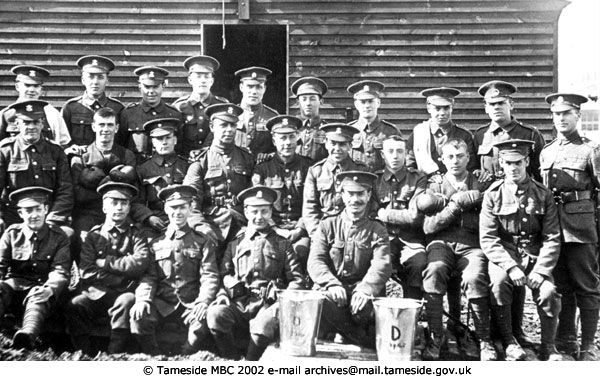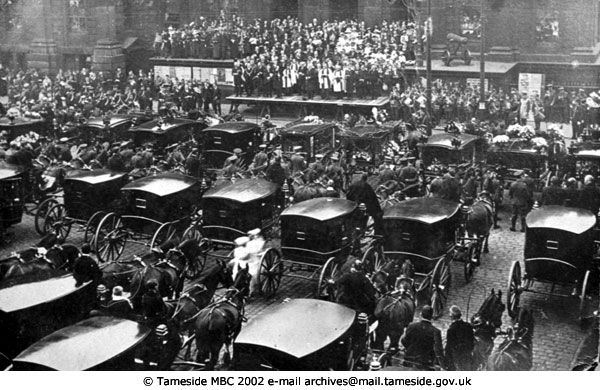Ashton-under-Lyne, History and Tragedy

For our latest series of blogs on Ashton-under-Lyne, we have chosen to look at the final months of World War 1 and how it impacted the people and the Town. Tragedy had already hit the local area a century ago last year when the local TNT factory exploded; resulting in many deaths and life-changing injuries. A total of forty-three were killed by the explosion at Hooley Hill Rubber and Chemical Works on June 13th, 1917. This included seven children from Saint Peters Primary School with one of them dying in the pool at Ashton Baths after the glass roof was destroyed.
The First World War had already brought tragedy to the local community, this event resulting in the need for more and more munitions factories; causing battlefield injuries to men, women and children. Bringing the war closer to the local community because of a factory being converted to munitions; which was next to the Town’s Gasometers. A recipe for disaster from the first but in a time of great need, with business under pressure from what was then the War Office; people’s safety just wasn’t considered.
The people and their injuries are long forgotten in the 21st century, at the time hundreds were made homeless, but the cost of war was to continue to hurt the Ashton under Lyne community for almost a further 18 months from that day until Armistice Day 11th November 1918. Our intent with this new series of Blogs on the fascinating history of our local community; is to celebrate the lives and bravery of the residents of Ashton under Lyne. With extracts from several local history sources, including; Tameside Local Studies, The Ashton Territorials and Wikipedia to name a few for now. As we move through 2018 we will remember those that came home and those that never returned.
The following are extracts from the The Telegraph and others of the lives changed and lost in early 1918. A century in our past but their sacrifice should never be forgotten, and we can only hope that this year will be the biggest celebration of their lives to take place since Armistice Day.
Ashton-under-Lyne, 22nd January 1918 – A Single Day of Loss
 The Telegraph dated 22nd January 1918 lists a total of 148 dead and 813 wounded, the figures released apply to the days previous. Tragically the news reported a further 427 missing in the same report and this is just from the perspective of British and Colonial Officers and Men. To put this into perspective, in the 74 days of the Falkland War; the UK lost a total of 255 military personnel. On the first day of the Battle of the Somme in 1914, the loss of British troops was over 20,000, highlighting the horror of trench warfare.
The Telegraph dated 22nd January 1918 lists a total of 148 dead and 813 wounded, the figures released apply to the days previous. Tragically the news reported a further 427 missing in the same report and this is just from the perspective of British and Colonial Officers and Men. To put this into perspective, in the 74 days of the Falkland War; the UK lost a total of 255 military personnel. On the first day of the Battle of the Somme in 1914, the loss of British troops was over 20,000, highlighting the horror of trench warfare.
On the same page as the details reported by The Telegraph on the 22nd of January, to prove that life continued in the local area. Redfern’s Rubber Works of Hyde advertised post-war enquiries for solid band tyres, cycle & motorcycle tyres, rubber heels & tips and economite soles for boots. I must assume most local businesses were producing goods for the war effort and a rubber factory like Redfern’s Rubber Works produced economite rubber soles for military footwear.
Ashton-under-Lyne, 15th February 1918
I have chosen this day because a century on it is the date of my 54th Birthday and although I was a member of the military when I was younger. We have still never lived through a time since the First World War when so many were lost from our Nation and of course in Ashton under Lyne. The actual total number of deaths due to WW1 in civilian and military terms exceeds 20 million people; almost 900,000 British Military perished. This war which affected so many towns and cities across the UK and of course the entire world was the biggest single loss of life associated with any war before or since.
Ashton-under-Lyne, George Kennedy
A soldier from Ashton under Lyne, a Mr George Kennedy who resided in the Hurst area of the town had a colourful career in the Army from 1900 to 1922. His first taste of battle was in the Boer War where he served in South Africa fighting to protect the British settlers. George remained a regular Soldier for many years before becoming a reservist, training regularly with his militia over many years, I say George’s history was colourful because he liked a drink. Which by all accounts got him in trouble regularly throughout his military career!
On the 15th of February 1918, George Kennedy was court-martialled near Saint Quentin in France for being drunk in active service. He was sentenced to 28 days but a month later he was defending Manchester Hill Saint Quentin, so named as it was captured by the Manchester Regiment in 1917. This battle though was lost as the regiment was overwhelmed by German forces reinforced by the troops from the Eastern Front. George Kennedy was captured following this action with many others who finished WW1 as POWs, George did not return home until December 1918.
Despite his colourful military service George Kennedy was a brave soldier having been awarded medals for all his campaigns. His medals were as follows:
- British War Medal
- The Queen’s South Africa Medal
- The Cape Colony Orange Free State Medal
- South Africa 1901 Medal
- The 1914-15 Star
- The Allied Victory Medal for Army Service
At least one of George’s medals can be found at the Museum of the Manchester Regiment in Ashton under Lyne; George’s military service did not end with the end of The Great War though, having worked as a Miner in Ashton under Lyne for a while he returned to the Army in 1921, till he was discharged finally in July 1922.
I hope you enjoyed the latest of our Ashton under Lyne Blogs and we will endeavour to continue these throughout 2018; not to celebrate a war that brought tragedy to the town and local area; but to remember the people and its impact on them.
Get started in seconds!
Save your details, view past orders, and enjoy a faster checkout every time.